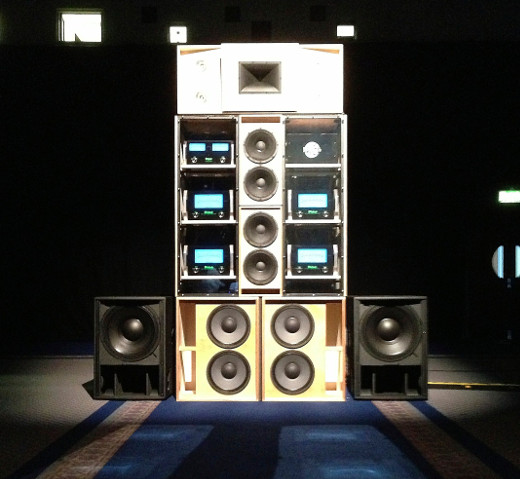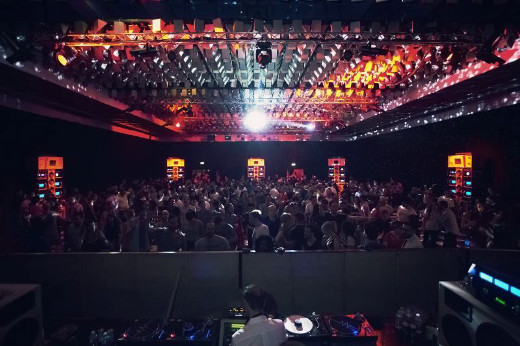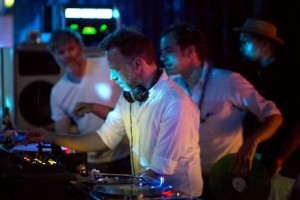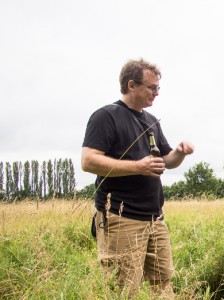The Soundsystem’s Sound System — How John Klett Designed “Despacio” with James Murphy
When LCD Soundsystem’s debut single, “Losing My Edge,” came out in 2002, James Murphy told us the story of being there – in the right scene, at the right place, at the right time.
The song serves as a testimony to the countless memorable moments in alternative music history, where the people who lived it can look back and boast “I was there.”
He was there, the lyrics read, at the very first Can show in West Germany in 1968. Six years later, he was at the New York City loft where Suicide held their first practices. He was there when Captain Beefheart put his first band together and he was at CBGB’s, the legendary club formerly situated near Manhattan’s Bowery-Bleecker intersection, giving the “rock kids” their first taste of Daft Punk.
Today, Murphy continues to find himself at the heart of the alt music scene. His recent escapades include a trip to the 2013 Manchester International Festival, where he wasn’t just spinning vinyl records (as per usual), he was unveiling his very own soundsystem: Despacio.

Despacio benefits from 15 years of collaboration between James Murphy and John Klett. (all photos by John Klett unless otherwise noted)
The for-vinyl-only soundsystem, comprised of seven 12-foot stacks, was imagined, designed and constructed by Murphy and audio technician/engineer/collaborator John Klett. Fifteen years Murphy’s senior, Klett has been building, tuning, adjusting and modifying soundsystems since the 1970s, making his name as one of New York City’s “audio gurus.” The two have been working together since the 1990s, most notably for the build out of Murphy’s DFA Studios in Manhattan.
We caught up with Klett to discuss his partnership with Murphy, as well as just how Despacio came to be.
Could you explain how you and James first got in touch and when you started working together?
I am not sure how we first connected. I guess he moved to NYC and was asking around and someone gave him my number. He called because he had a large MCI JH-536D console and I had an MCI JH-540D. He also had a couple of 3M M79 2” machines. I went to Brooklyn and we talked consoles and tape machines.
He had been in a band named Pony and went under another name. I remember one song from them called “Prize Fighter” – I had heard that before. He gave me a couple of those CD’s.
He approached me as an engineer who wanted to get a studio together. We listened to Kraftwerk and Aphex Twin stuff. He has great music knowledge and taste. As far as knowing his history, he was 25 and knew what he wanted. That’s all I cared about.
Recently, I was at James’ studio tuning speakers and he turned to me and said “today is my birthday.” I said “oh, well happy birthday.” Then he asked how old I was and I said “I’m 55.” He said “do you know that I am the same age (40) that you were when we met?” We had just listened to a rough mix of Drunk Girls so whatever that means if you work it back – 1996 I guess.
James just fell out of the sky. He’s just this guy … y’know?
What are some projects that you have worked on together in the past?
When we met he was putting together a studio in Brooklyn. We talked about renovating the console and tape machines and about acoustics and speakers and such. He ended up landing a space in Manhattan with a friend of his so I brought my team in and we put that together.
I rebuilt the 3M tape machines and did a lot of work on his console. James bought a new analog desk that seemed to be a good idea at the time. It turned out to be cool in some ways but it had some really serious flaws. We had to make the mutes really mute and the faders fade all the way. Crosstalk was a huge issue. We did extensive mods to make that console really work and this culminated in replacing the entire center section. Andrew Roberts (who is now Purple Audio) was working with me at the time and I handed that project over to him to do.
After the DFA studio got going I’d come in to deal with fixing a tape machine or mix down deck or something. I set up an OS-X mostly UNIX server there (1998!) and helped Marcus extract and update email address lists for the fledgling DFA operation.
I’d be there a lot and bring one or the other or both my boys, who were small then, and they would play Nintendo on the huge drop down projection screen in what would be the room where the first big DFA parties happened.
After that… We were both busy doing things all the time. Months or years would go by and then a conversation starts up, kind of picking up where one may have left off two years back, or maybe something new.
Right now he’s building a home studio and I’m helping with that. We need another console and we’re trying to figure that out. He suggested we buy a couple of the same consoles he has at DFA and modifying them. I think I turned green and looked like I was going to be ill when he told me that so he dropped it (I hope).
Could you discuss the creative process when you two work together?
We have these high bandwidth conversations, very nerdy-geeky, that cover a lot of things. These are best done in the real and are very enjoyable. Ideas come like water out of a tap. It’s like opening up the valves and letting a lot of current flow. My brain feels hot after a couple hours of this, but he makes great coffee and that keeps it going. He likes post it notes so he sticks them on my drawings and we take pictures of the notes. I keep folders of this stuff.
We are often off in other places so it’s like we are on two planets in different orbits most of the time but when we line up we yell ideas at each other. If he’s in town and has time and I have time then we get together and we make the air heat up between us like plasma. After that I’m on my own. He preloads the ethos and I’ll just run with it. I’ll send drawings and write tomes, he’ll text or write one-liners. Then nothing happens for a while until the planets line up again and I go for coffee and a high bandwidth exchange.
Don’t miss this mini-doc from Vinyl Factory on Despacio, including interviews with James Murphy, 2ManyDJs and John Klett.

How did the Despacio project get started?
When This is Happening came out, I downloaded it the first day it went up and I did what I do. I have big speakers all over my house so I went in to the kitchen and was blasting the record through these Klipsch Cornwalls I have in there. I was bopping around and cooking lunch and really enjoying that record. I texted James that I was listening to “One Touch” really loud on my Cornwalls and that it was rocking.
He texted back first that he wanted Cornwalls then he changed that to La Scalas, which is a fully horn-loaded Klipsch speaker. I told him the bass in the La Scala was not so hot but the mid horns were better than in the Cornwalls. What he should have are Cornscalas, a Cornwall with a bigger mid horn like the La Scala has. People build these hybrids and they exist. They sound good too.
So that’s when is started – May, 2010. And it just grew from there.
Could you talk about the system’s design?
Well it’s a very simple system. We have these large stacks. For this show we are using seven of the eight. Each stack is a five-way system with a pair of 21” subs that we brought in, two double 15” cabinets, two double 12” cabinets and a “bird house” that sits on top. The birdhouse has a large horn flare driven by a 1.5” compression driver. There are four “bullet” UHF/tweeters that are mounted on angled facets to cover the floor area in front of the stack.
The subs have their own power; 4800 Watts total per stack. Each of the four boxes with two 12” or two 15” drivers in them are fed from a McIntosh MC-1.2KW monoblock amplifier. We have an MC-452 driving the upper mid horn and the UHF drivers. Those are very efficient, so 450 for each of those bands is plenty. The 12” boxes run up the middle of the stack and there are box steel framed cases on either side that hold the amplifiers. The front of those are thick Plexiglas and essentially form an extended baffle for the 12’ column of speakers. The two cabinets with 12’s and 15’s are old school, non-ducted vented reflex enclosures similar to James B Lansing signature series C35’s, old Tannoy Lockwood cabinets, Bozak and Altec 612 cabinets.
The vent velocities are very low and they are not hyper-tuned; they sound like speaker cabinets but it’s not a complicated, processed sort of a sound that you get from these. They have a different character altogether from what people are using today; more natural, relaxed and organic sounding.
Did the fact that the DJ’s will only be playing vinyl records affect the systems design at all?
Yes. I knew that we did not have to really stretch the subs down to infrasonic. I’d have gone with something that could get me down to 8Hz if we were doing “born-digital” material.
What challenges came up?
Time, space, weight and budget.
Getting people to wrap their heads around this absurd system is also a challenge. I have described this thing to people and, conceptually, some people – you can see the light bulb light up. Other people have seen pictures in the press or read about it and they start talking about how the system sounds by looking at a picture and they mostly seem to talk about how it can’t possibly sound good because of this or that. We call that “look and talk” or “see and say.” People can’t hear with their eyeballs but these “see and say” people somehow feel they can blab about this and that having never heard anything. It’s all silliness and nonsense until you go hear the thing. The ONLY information that finally makes it make sense is hearing the system.
What skill of yours would you most attribute to your success in this field and on this kind of project?
The ability to just go ahead and do crazy shit no matter how much other people will tell you it will never work. Kids do this all the time but most people seem to think that is something that you need to grow out of – they become nay-sayers.
Knowing some physics helps. Some things are impossible; other things are just impractical, very difficult or expensive. Kind of like this project…
Are there plans for this sound system to be installed anywhere else?
It’s going to tour … I have no idea what the schedule for that is.
I am working up specs and pricing for a three phase 208Y to 415Y power conversion system. We need to find places that have a LOT of power and can handle the weight.
I’d like a pair of these stacks for my house. First I need a bigger house, so Cornscalas are more practical for now.
***
Despacio System Specifications — supplied by John Klett
Weight: Over one metric ton per stack. The whole system weighs over ten tons before it’s put into shipping cases
Power Required: Each stack requires two electrical feeds at 230 volts (in the UK), one 16 Amp and one 32 Amp feed. Two 63 Amp three phase distributions feed power to this. That is European three phase so instead of each leg sitting at 117 volts and the phase to phase being 208 volts it’s all nearly double. In USA lingo we would call it 415 “Y”.
Total Amplifier Power: Roughly 80,000 Watts with about 50,000 Watts in McIntosh power. There is access to all of that power due to the transformer matching these amps do on their outputs… plus at least 2dB in dynamic headroom… i.e. the 1200 Watt monoblocks can actually do 2000 Watts peak.
The subs are Class D… and that is purely practical… the 2000 Watts monoblocks from McIntosh are enormous… each one is three big heavy blocks… I mean… if we were not over the top already I would say that adding sixteen MC-2KW monoblocks would put us there.
(There are many more photos of Despacio to be found on John Klett’s personal site, technicalaudio.com)
Watch out for John Klett at the upcoming 135th AES Convention — he’ll be all over the Javits Center, talking about tech and his NonLinearAudio Flexiguy 500 mic/line/instrument preamp module.
Jon Lurie is an audio engineer and musician living in Sunnyside, Queens. His favorite Beatles album is Abbey Road. Follow him on the interweb @jon_lurie.
Please note: When you buy products through links on this page, we may earn an affiliate commission.











DPrty
October 7, 2013 at 12:40 am (12 years ago)I could use a set of those in my living room.
Bishop Coxcomb
October 10, 2013 at 9:43 am (12 years ago)I was just building this setup in my head and imagining it here in front of me.